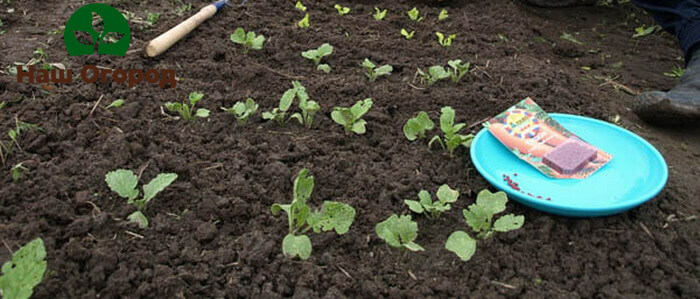Important tips for planting beets outdoors
Content:
Beets in the garden: Choosing a planting site
The place for planting beets must be sunny. Beets can be planted in one row at the edge of any garden bed. So planting is convenient for those who have little space. With such a planting, it is not necessary to prepare a separate bed for the beets. Beets in the garden like to grow after potatoes, zucchini, squash, peas, cucumbers, tomatoes and eggplant.
Beets in the garden and soil preparation for planting
In order to grow a good harvest of beets, it is necessary to prepare the beds in the fall. A rich harvest is possible only in soil with a high organic content, so in the fall it is advisable to add compost to the beds and dig up. If the soil in the garden is acidic, then it must be deacidified, because beets do not like acidic soils. This can be done by adding lime or dolomite flour, or just ash to the soil. The soil, with a high clay content, will prevent the beets from growing large and juicy.
When to plant beets
Beets should be planted in spring only when the ground warms up to 10⁰. This is usually April or early May. It depends, of course, which region and which spring. If sown earlier, in cold and wet soil, the seeds can simply rot. And if they do, they can go into the trunk, and you will be left without a crop.
Seed soaking
Root crops can be planted with seedlings or sown with seeds. For quick germination of seeds, in order for seedlings to appear on them quickly, the seeds can be soaked for 24 hours. This can be done in epine or zircon, as well as in humate. For additional growth support, you can use a solution of wood resin - 1 teaspoon per glass of water. The seeds are kept in this solution for 4-6 hours. When the time is up, the seeds are washed with warm water and wrapped in a dry piece of cloth so that they dry out. It is more convenient to sow dry seeds into the soil. Sprouted seeds can be sown. To do this, they must be placed in a damp cotton cloth or in wet paper napkins, then the napkin must be put in a bag and kept in a warm place for 2 days. Sprouted seeds will sprout much faster after planting, especially if the weather is warm.

Preparing the beds for planting
If the land is poor and infertile, then a week before planting, you can apply mineral fertilizers, for example, nitroammafosku, to the ground, then loosen and water the soil well. Before sowing, grooves with a depth of 2-3 centimeters must be made in the garden, and the distance between the grooves is 25-30 centimeters. Then scatter the ash along all the grooves and walk along the grooves with a flat cutter, gently mixing the top layer of soil with ash. After this, the grooves must be shed.
Disinfection of beds
To disinfect the soil, spill the wells with a dark solution of potassium permanganate or a solution of phytosporin (it fights against fungal infections) and replenish the soil with live microorganisms. The solution requires 1 tablespoon of phytosporin per 10 liters of water. As soon as the water is absorbed in the holes, you can start sowing.
Planting recommendations
The distance of comfortable growth of beets is 8-9 centimeters from each other. After sowing the seeds, the grooves are sprinkled with a thin layer of soil. It is not necessary to water the grooves on top so that an earthen crust does not form. The bed can be covered with foil or agrofiber to retain heat and moisture. As soon as the seedlings germinate, the film must be removed.

Fertilizing beets in the garden for a large harvest
You can start feeding the beets when the first true leaves appear. It can be chicken droppings, green manure, mullein. Also, several times per season, you can pour ash under the beets. Beets do not like waterlogging, so it is necessary to water it in moderation and be sure to periodically loosen it.
We wish you a rich harvest!

